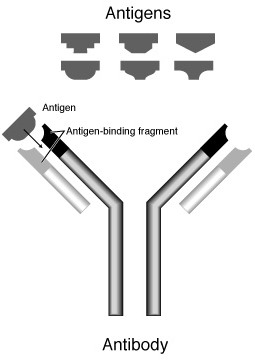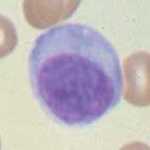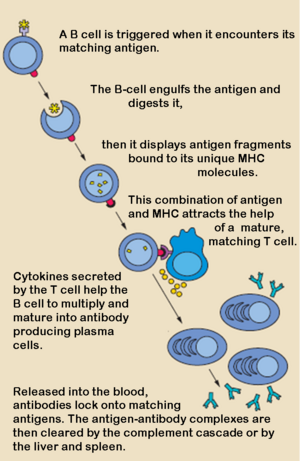B cell

B cells are lymphocytes (a class of white blood cells) that play a large role in the adaptive immune system by making antibodies to identify and neutralize invading pathogens like bacteria and viruses. Specifically, B cells play a prominent role in the humoral immune response, as opposed to the cell-mediated immune response that is governed by T cells, another type of lympocyte.
The humoral immune system involves complex coordination that is truly remarkable. The human body can produce millions of types of B cells, each with a unique receptor protein. This allows protection against millions of possible pathogensâall the while recognizing those cells that are part of the body and are not to be attacked, specifically mobilizing against invaders.
The abbreviation "B" comes from bursa of Fabricius, an organ in birds in which avian B cells mature. (It does not stand for bone marrow, where B cells are produced in all other vertebrates except for rabbits. B cells were originally observed in studies done on immunity in chickens.) They are also called B lymphocytes.
Overview: B cells and the immune system
B cells are part of the adaptive immune system, also called the "acquired immune system, and "specific immune system." The system involves processes whereby animals that survive an initial infection by a pathogen are generally immune to further illness caused by that same pathogen. The basis of specific immunity lies in the capacity of immune cells to distinguish between proteins produced by the body's own cells ("self" antigen), and proteins produced by invaders or cells under control of a virus ("non-self" antigen).
In many species, the adaptive immune system can be divided into two major sections, the humoral immune system and the cell-mediated immune system. The B cells are part of the humoral immune system.
The humoral immune system acts against bacteria and viruses in the body liquids by means of proteins, called immunoglobulins (also known as antibodies), which are produced by B cells. Secreted antibodies bind to antigens on the surfaces of invading microbes (such as viruses or bacteria), which flags them for destruction. An antigen is any substance that causes the immune system to produce antibodies.
The human body has the ability to form millions of different types of B cells each day, and each type has a unique receptor protein (referred to as the B cell receptor, BCR) on its membrane that will bind to one particular antigen. At any one time in the human body there are B cells circulating in the blood and lymph, but are not producing antibodies. Once a B cell encounters its cognate antigen and receives an additional signal from a helper T cell, it can further differentiate into one of two types of B cells.
B cells need two signals to initiate activation. Most antigens are T-dependent, meaning T cell help is required for maximal antibody production. With a T-dependent antigen, the first signal comes from antigen cross linking BCR (B cell receptor) and the second from the Th2 cell. Some antigens are T-independent, meaning they can deliver both the antigen and the second signal to the B cell.
An antibody is a large Y-shaped protein used to identify and neutralize foreign objects like bacteria and viruses. Each antibody recognizes a specific antigen unique to its target. This is because at the two tips of its "Y," it has structures akin to locks. Every lock only has one key, in this case, its own antigen. When the key is inserted into the lock, the antibody activates, tagging or neutralizing its target. The production of antibodies is the main function of the humoral immune system. The terms antibody and immunoglobulin are often used interchangeably
In humans, there are five types of antibodies: IgA, IgD, IgE, IgG, and IgM (Ig stands for immunoglobulin). This is according to differences in their heavy chain constant domains. (The isotypes are also defined with light chains, but they do not define classes, so they are often neglected.)
The antibodies that a single B lymphocyte produces can differ in their heavy chain, and the B cell often expresses different classes of antibodies at the same time. However, they are identical in their specificity for antigen, conferred by their variable region. To achieve the large number of specificities the body needs to protect itself against many different foreign antigens, it must produce millions of B lymphoyctes. In order to produce such a diversity of antigen binding sites for each possible antigen, the immune system would require many more genes than exist in the genome. It was Susumu Tonegawa who showed, in 1976, that portions of the genome in B lymphocytes can recombine to form all the variation seen in the antibodies and more. Tonegawa won the Nobel Prize in Physiology or Medicine in 1987, for his discovery.
Development of B cells
B cells are produced in the bone marrow of most mammals. Rabbits are an exception; their B cells develop in the appendix-sacculus rotundus.
B cell development occurs through several stages, each stage representing a change in the genome content at the antibody loci. An antibody is composed of two light (L) and two heavy (H) chains, and the genes specifying them are found in the "H" chain locus and the "L" chain locus. In the H chain loci, there are three regions, V, D, and J, which recombine randomly, in a process called VDJ recombination, to produce a unique variable domain in the immunoglobulin of each individual B cell. Similar rearrangements occur for L chain locus except there are only two regions, V and J. The list below describes the process of immunoglobulin formation at the different stages of B cell development.
- Progenitor B cellsâContains Germline H genes, Germline L genes
- Early Pro-B cellsâundergoes D-J rearrangement on the H chains
- Late Pro-B cellsâundergoes V-DJ rearrangement on the H chains
- Large Pre-B cellsâthe H chain is VDJ rearranged, Germline L genes
- Small Pre-B cellsâundergoes V-J rearrangement on the L chains
- Immature B cellsâVJ rearranged on L chains, VDJ rearranged on H chains. There is start of expression of IgM receptors.
- Mature B cellsâThere is start of expression of IgD
When the B cell fails in any step of the maturation process, it will die by a mechanism called apoptosis. If it recognizes self-antigen during the maturation process, the B cell will become suppressed (known as anergy) or undergo apoptosis. B cells are continuously produced in the bone marrow, but only a small portion of newly made B cells survive to participate in the long-lived peripheral B cell pool.
Functions and types
The human body makes millions of different types of B cells each day that circulate in the blood and lymph, performing the role of immune surveillance. They do not produce antibodies until they become fully activated.
Each B cell has a unique receptor protein, the B cell receptor (BCR), on its surface, that will bind to one particular antigen. The BCR is a membrane-bound immunoglobulin, and it is this molecule that forms the distinction of B cells from other types of lymphocytes, as well as being the main protein involved in B cell activation. Once a B cell encounters its cognate antigen and receives an additional signal from a T helper cell, it can further differentiate into one of the two types of B cells listed below.
Mature B cells differentiate into either plasma B cells or memory B cells. The B cell may either become one of these cell types directly, or it may undergo an intermediate differentiation step, the germinal center reaction, where the B cell will hypermutate the variable region of its immunoglobulin gene and possibly undergo class switching.
During the initial stages of an immune response, the lifespan of plasma cells is very short, typically only a few days to weeks. However, following the process of affinity maturation, plasma cells can survive for months to years and continue to secrete high levels of antibodies.
Memory B cells tend to be longer-lived and can therefore respond quickly upon second exposure to an antigen. In the wake of first (primary response) infection involving a particular antigen, the responding naŃve (ones which have never been exposed to the antigen) cells proliferate to produce a colony of cells, most of which transform into the plasma cells or the effector B cells (which produce the antibodies) and clear away with the resolution of infection, and the rest persist as the memory cells that can survive for years, or indeed even for a lifetime.
B cell types
- Plasma B cells (also known as plasma cells) are large B cells that have been exposed to antigen and are producing and secreting large amounts of antibodies, which assist in the destruction of microbes by binding to them and making them easier targets for phagocytes and activation of the complement system. They are sometimes referred to as antibody factories. Most plasma B cells travel to the spleen or bone marrow to secrete antibodies (approximately 10,000 per second). An electron micrograph of these cells reveals large amounts of rough endoplasmic reticulum, responsible for synthesizing the antibody, in the cell's cytoplasm.
- Memory B cells are a B cell sub-type that are formed following primary infection. They are formed from activated B cells that are specific to the antigen encountered during the primary immune response. These cells are able to live for a long time, and can respond quickly following a second exposure to the same antigen.
B-1 cells express IgM in greater quantities than IgG and its receptors show polyspecificity, meaning that they have low affinities for many different antigens, but have a preference for other immunoglobulins, self antigens, and common bacterial polysaccharides. B-1 cells are present in low numbers in the lymph nodes and spleen and are instead found predominantly in the peritoneal and pleural cavities. B-2 cells are the conventional B cells most texts refer to.
Recognition of antigen by B cells
A critical difference between B cells and T cells is how each lymphocyte "sees" its antigen. B cells recognize their cognate antigen in its native form. They recognize free (soluble) antigen in the blood or lymph using their BCR or membrane bound-immunoglobulin. In contrast, T cells recognize their cognate antigen in a processed form, as a peptide fragment presented by an antigen-presenting cell's major histocompatibility complex (MHC) molecule to the T cell receptor.
Activation of B cells
B cell recognition of antigen is not the only element necessary for B cell activation (a combination of clonal proliferation and terminal differentiation into plasma cells). B cells that have not been exposed to antigen, also known as "Naive B cells," can be activated in a T-cell dependent or independent manner.
T-cell dependent activation
When a B cell ingests a pathogen, it attaches parts of the pathogen's proteins to a class II MHC protein. This complex is moved to the outside of the cell membrane, where it can be recognized by a T lymphocyte, which is compatible with similar structures on the cell membrane of a B lymphocyte. If the B cell and T cell structures match, the T lymphocyte activates the B lymphocyte, which produces antibodies against the bits of pathogen, called antigen, it has presented on its surface.
Most antigens are T-dependent, meaning T cell help is required for maximal antibody production. With a T-dependent antigen, the first signal comes from antigen cross linking the B cell receptor (BCR) and the second signal comes from co-stimulation provided by a T cell. T dependent antigens contain proteins that are presented on B cell Class II MHC to a special subtype of T cell called a Th2 cell. When a B cell processes and presents the same antigen to the primed Th cell, the T cell secretes cytokines that activate the B cell. These cytokines trigger B cell proliferation and differentiation into plasma cells. Isotype switching to IgG, IgA, and IgE and memory cell generation occur in response to T-dependent antigens. This isotype switching is known as Class Switch Recombination (CSR). Once this switch has occurred, that particular B-cell can no longer make the earlier isotypes, IgM or IgD.
T-cell independent activation
Many antigens are T-independent, meaning they can deliver both of the signals to the B cell. Mice without a thymus (nude or athymic mice that do not produce any T cells) can respond to T-independent antigens. Many bacteria have repeating carbohydrate epitopes that stimulate B cells, through so called pattern recognition receptors, to respond with IgM synthesis in the absence of T cell help. There are two types of T-cell independent activation; Type 1 T cell-independent (polyclonal) activation, and type 2 T cell-independent activation (in which macrophages present several of the same antigen in a way that causes cross-linking of antibodies on the surface of B cells).
The ancestral roots of B cells
In an October 2006, issue of Nature Immunology, it was reported that certain B-cells of primitive vertebrates (like fish and amphibians) are capable of phagocytosis, a function usually associated with cells of the innate immune system. The authors of this article postulate that these phagocytic B-cells represent the ancestral history shared between macrophages and lymphocytes; B-cells may have evolved from macrophage-like cells during the formation of the adaptive immune system (Li et al. 2006).
B cells in humans (and other vertebrates) are nevertheless able to endocytose antibody-fixed pathogens, and it is through this route that MHC Class II presentation by B cells is possible, allowing Th2 help and stimulation of B cell proliferation. This is purely for the benefit of MHC Class II presentation, not as a significant method of reducing the pathogen load.
ReferencesISBN links support NWE through referral fees
- Alberts, B., D. Bray, J. Lewis, M. Raff, K. Roberts, and J.D. Watson. 1989. Molecular Biology of the Cell, 2nd edition. New York: Garland Publishing. ISBN 0824036956
- Janeway, C., P. Travers, M. Walport, and M. Shlomchik. 2001. Immunobiology, 5th edition. New York: Garland Science. ISBN 0815341016
- Li, J., D.R. Barreda, Y.A. Zhang, H. Boshra, A.E. Gelman, S. LaPatra, L. Tort, and J.O. Sunyer. 2006. B lymphocytes from early vertebrates have potent phagocytic and microbicidal abilities. Nature Immunology 7: 1116â1124. Retrieved April 4, 2025.
External links
All links retrieved April 4, 2025.
- B Cells Cleveland Clinic
- BiteSized Immunology: B Cells British Society for Immunology
- B Cell Overview Thermo Fisher Scientific
| Immune system - edit |
|---|
| Humoral immune system | Cellular immune system | Lymphatic system | White blood cells | Antibodies | Antigen (MHC) | Complement system | Inflammation | Clotting factors |
Credits
New World Encyclopedia writers and editors rewrote and completed the Wikipedia article in accordance with New World Encyclopedia standards. This article abides by terms of the Creative Commons CC-by-sa 3.0 License (CC-by-sa), which may be used and disseminated with proper attribution. Credit is due under the terms of this license that can reference both the New World Encyclopedia contributors and the selfless volunteer contributors of the Wikimedia Foundation. To cite this article click here for a list of acceptable citing formats.The history of earlier contributions by wikipedians is accessible to researchers here:
The history of this article since it was imported to New World Encyclopedia:
Note: Some restrictions may apply to use of individual images which are separately licensed.


